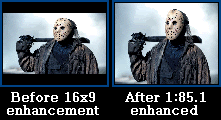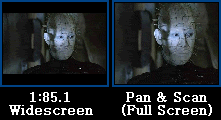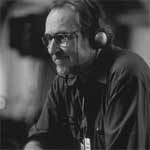Post by Chucky on Dec 10, 2004 16:41:31 GMT -5
I notice a lot of people, some dvd reviewers may be a little confused when it comes to this stuff. So I thought I'd take it upon myself to explain this really simply.
The aspect ratio[/i] is the size of the screen displayed, widescreen, full screen etc. The ratio is the exact size of the screen.

Movies in Full screen are either defined as being 4x3 or 1:33.1 as movies in widescreen vary. A lot of the new blockbuster action films are presented in a 2:35.1 widescreen (see pic above) but sometimes they like to get sneaky and make it 2:40.1 but ultimately it is almost the same. A lot of other films usually gor for a 1:85.1 screen (see pic above) but sometimes it is 1:78.1 not much of a difference here either.
16x9 (anamorphic widescreen) is a wonderful thing. It should allow you to watch anything in widescreen (from 1:85.1 or lower) as fullscreen. This means the picture is stretched vertical. You may notice people or objects being slightly slimmer than they used to but this isn't a big deal and is hardly noticeable but if it bothers you that much, you can always make the choice of not using it. See an example of a 1:85.1 widescreen enhanced below...

When you use 16x9 on an aspect ratio that is higher than 1:85.1, it'll still stretch the picture vertically but not to full screen, it will stretch it out to the size of 1:85.1 so you get less black bars and more viewing space for those movies in huge-ass widescreens. See an example of a 2:35.1 widescreen enhanced below...

The last thing to know about this is the dreaded Pan & Scan feature. This is what most people would be familiar with. This is the full screen version of the film. Pan & Scan option will search for the closest ratio to full screen without any enhancements. So if your dvd only has a 1:85.1 enhanced, it will show the 1:85.1 screen.
Some dvd's like my UK r2 Wishmaster disc gives the option of a 1:85.1 widescreen, enhanced and also pan & scan full screen option. I'll show you an example below...

Notice how the full screen looks different to the 1:85.1 widescreen in the sense that the fullscreen is missing some off the sides?
Some dvd players let you change ratios while the movie is playing, some of them only allow you to do it before the player has loaded the disc. In some instances some discs only allow you to do it before its been loaded, some let you change them while they play but if you change the ratios before the disc is loaded, you should be able to find out what kind you can select.
Letterbox: The widest screen to watch the movie in.
16x9: The enhanced widescreen version.
Pan & Scan (4x3): Full screen version, like the kind you seen on all of your old VHS tapes.
Okay, hopefully I've helped you understand some of this shiz.
The aspect ratio[/i] is the size of the screen displayed, widescreen, full screen etc. The ratio is the exact size of the screen.

Movies in Full screen are either defined as being 4x3 or 1:33.1 as movies in widescreen vary. A lot of the new blockbuster action films are presented in a 2:35.1 widescreen (see pic above) but sometimes they like to get sneaky and make it 2:40.1 but ultimately it is almost the same. A lot of other films usually gor for a 1:85.1 screen (see pic above) but sometimes it is 1:78.1 not much of a difference here either.
16x9 (anamorphic widescreen) is a wonderful thing. It should allow you to watch anything in widescreen (from 1:85.1 or lower) as fullscreen. This means the picture is stretched vertical. You may notice people or objects being slightly slimmer than they used to but this isn't a big deal and is hardly noticeable but if it bothers you that much, you can always make the choice of not using it. See an example of a 1:85.1 widescreen enhanced below...

When you use 16x9 on an aspect ratio that is higher than 1:85.1, it'll still stretch the picture vertically but not to full screen, it will stretch it out to the size of 1:85.1 so you get less black bars and more viewing space for those movies in huge-ass widescreens. See an example of a 2:35.1 widescreen enhanced below...

The last thing to know about this is the dreaded Pan & Scan feature. This is what most people would be familiar with. This is the full screen version of the film. Pan & Scan option will search for the closest ratio to full screen without any enhancements. So if your dvd only has a 1:85.1 enhanced, it will show the 1:85.1 screen.
Some dvd's like my UK r2 Wishmaster disc gives the option of a 1:85.1 widescreen, enhanced and also pan & scan full screen option. I'll show you an example below...

Notice how the full screen looks different to the 1:85.1 widescreen in the sense that the fullscreen is missing some off the sides?
Some dvd players let you change ratios while the movie is playing, some of them only allow you to do it before the player has loaded the disc. In some instances some discs only allow you to do it before its been loaded, some let you change them while they play but if you change the ratios before the disc is loaded, you should be able to find out what kind you can select.
Letterbox: The widest screen to watch the movie in.
16x9: The enhanced widescreen version.
Pan & Scan (4x3): Full screen version, like the kind you seen on all of your old VHS tapes.
Okay, hopefully I've helped you understand some of this shiz.



